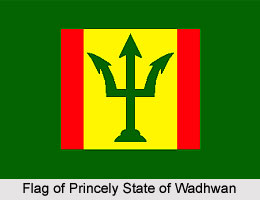 The Princely State of Wadhwan was one of the Salute states of India during the rule of the British Empire in India which was administered by native rulers or Indian princes under the indirect control of the British Government of India. The territory covered a total area of 242.6 sq m and after inclusion of the states attached in 1943, the area became 464 sq m. Wadhwan state comprised of a total population of 50,915 in the year 1941, and after the year 1943, the population of the region rose to 69,245, including the states attached. It was under the incorporated as a part of the Baroda Agency, which was under Western India States Agency. The state was later merged with the state of Gujarat.
The Princely State of Wadhwan was one of the Salute states of India during the rule of the British Empire in India which was administered by native rulers or Indian princes under the indirect control of the British Government of India. The territory covered a total area of 242.6 sq m and after inclusion of the states attached in 1943, the area became 464 sq m. Wadhwan state comprised of a total population of 50,915 in the year 1941, and after the year 1943, the population of the region rose to 69,245, including the states attached. It was under the incorporated as a part of the Baroda Agency, which was under Western India States Agency. The state was later merged with the state of Gujarat.
The Princely State of Wadhwan included around thirty villages and few holdings in the British Ahmedabad district. It was located in the north-eastern Kathiawar region and comprised of 5 distinctive blocks of territory. Wadhwan state was bordered by Dhrangadhra in the north; by territory belonging to Ahmedabad, Limbdi and Chuda in the south; and by Sayla and Muli in the west. Wadhwan state was honoured as one of the salute states with a gun salute of 9 guns. Wadhwan was previously a former Second Class state and ranked in 18th position in order of precedence amongst the states of Western India, under Rajkot. The courts of the princely state exercised full civil and criminal jurisdiction. Wadhwan state paid tribute to the state of Jungadh and gathered tribute from the talukdars of Bhalala, Gundiala, Kherali Jhampodad and Jhamar. The native ruler of Wadhwan state, who held the title of Thakor Saheb, was an original member of the Chamber of Princes in his own right.
The Jhala Rajputs were the ruling family of the state of princely state. After the death of the founder of the Jhala kingdom, Thakore Chandrasinghji of Halvad Dhrangadhra, Ashkaranji, his 2nd son, seized the royal throne or gadi to the disadvantage of Rajolji and Sartanji, sons of his late eldest brother Prithiraji and also his nephews. The brothers were supported by the Jam Sahib of Nawanagar and fought and obtained the state of Wankaner from the savages and established an autonomous kingdom in the year 1630. Later Rajoji, his younger brother, founded the state of Wadhwan. The states of Jhamar, Chuda and Jhalawar in Rajputana were founded in turn by native rulers of the Wadhwan House.
According to the 1943 Attachment Scheme, the princely state of Wadhwan attached 12 units, primarily from the district of Wadhwan and Bhoika Thanas, and covered of a total area of 222 sq m and comprised of a total population of 18, 350. The region was earlier known as Wardhmanpuri. After the withdrawal of the British administration and Indian independence, the princely state was acceded to the Union of India.



















